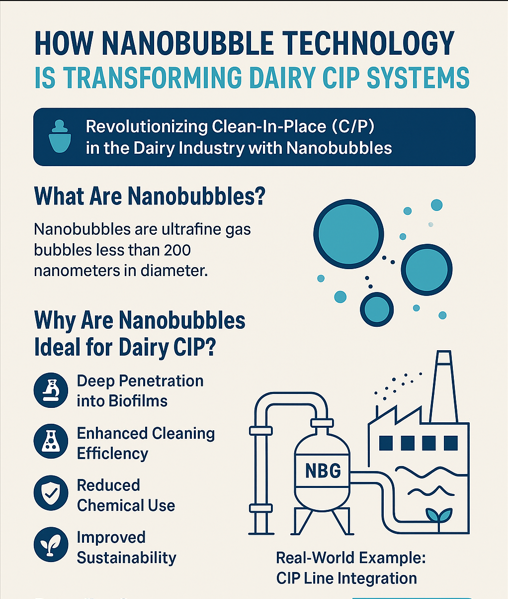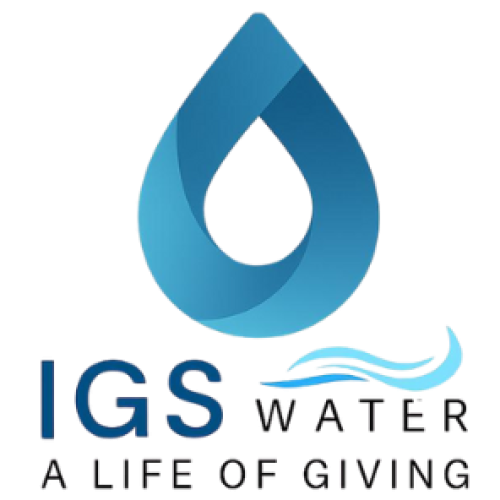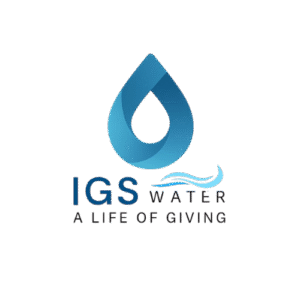🧼🥛 Revolutionizing Clean-in-Place (CIP) in the Dairy Industry with Nanobubbles
The dairy industry is one of the most hygiene-sensitive sectors, where equipment cleanliness directly affects product quality, safety, and shelf life. Traditional Clean-in-Place (CIP) systems rely heavily on water, chemicals, heat, and time to clean pipelines, tanks, and other equipment—leading to high operational costs and environmental concerns.
But what if there was a smarter, greener way to clean?
Enter nanobubble technology—a cutting-edge innovation that’s changing the game in CIP processes across dairy operations.
What Are Nanobubbles?
Nanobubbles are ultrafine gas bubbles less than 200 nanometers in diameter—about 2,500 times smaller than a grain of salt. Unlike regular bubbles, they:
- Remain stable in liquids for long periods
- Generate strong oxidative power
- Improve gas solubility (like oxygen or ozone)
- Create shockwaves during collapse to remove contaminants
These properties make nanobubbles powerful cleaning agents—without the need for excessive chemicals or heat.
🧪 Why Are Nanobubbles Ideal for Dairy CIP?
Dairy processing equipment is prone to stubborn residues like:
- Protein and fat buildup
- Biofilm formation from bacteria
- Mineral scaling (e.g., calcium deposits)
Traditional cleaning requires multiple steps: pre-rinse, caustic wash, acid wash, sanitization, and rinses in between—all consuming water, energy, and chemicals.
Nanobubble technology enhances or even replaces parts of this process by:
✅ 1. Deep Penetration into Biofilms
Nanobubbles reach into microscopic crevices and disrupt biofilm matrices, which conventional chemicals often fail to remove completely.
✅ 2. Enhanced Cleaning Efficiency
When infused with gases like oxygen or ozone, nanobubbles generate reactive oxygen species (ROS) that break down organic matter more effectively.
✅ 3. Reduced Chemical Use
Nanobubbles can reduce the need for strong caustic or acid chemicals—making the CIP process greener and safer.
✅ 4. Improved Sustainability
Less chemical usage + lower water consumption + shorter cleaning cycles = a more eco-friendly dairy operation.
🏭 Real-World Example: CIP Line Integration
Imagine a dairy plant’s pipeline system retrofitted with a Nanobubble Generator (NBG) inline with its rinse water line. When cleaning begins:
- Water + nanobubbles flow through the system
- Bubbles penetrate residues and biofilms
- Proteins and fats are loosened without excessive detergents
- Shorter rinsing needed post-chemical wash (if used)
- The result: Clean equipment, lower costs, higher hygiene
| Benefit | Traditional CIP | CIP with Nanobubbles |
|---|---|---|
| Water consumption | High | Reduced by 20–30% |
| Chemical usage | High | Reduced by 40–80% |
| Cleaning time | Long cycles | Shorter, more effective |
| Biofilm removal | Incomplete | Deeper penetration |
| Environmental footprint | High | Significantly lower |
🌱 Moving Toward a Chemical-Free Future
Some dairy innovators are exploring chemical-free or low-chemical CIP cycles using nanobubbles alone or in combination with ozone, electrolyzed water, or UV. With increasing pressure to reduce chemical residues in food production, nanobubbles offer a promising path forward.
🧭 Conclusion: Small Bubbles, Big Impact
Nanobubble technology brings precision, efficiency, and sustainability to dairy cleaning operations. Whether you’re managing a large dairy plant or looking for new ways to optimize cleaning protocols, nanobubbles can cut costs, improve hygiene, and protect the environment.


